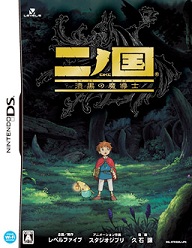Pokemon Diamond/Pearl
Nintendo DS
Reviewed: 06/07/2007
 Pokémon Diamond and Pearl are the latest installments in a long-standing “Gotta catch ’em all” series, and despite being very similar to their predecessors in many ways, they manage to bring several new elements (and Pokémon) to the table.
Pokémon Diamond and Pearl are the latest installments in a long-standing “Gotta catch ’em all” series, and despite being very similar to their predecessors in many ways, they manage to bring several new elements (and Pokémon) to the table.
The storyline of Pokémon Diamond/Pearl is pretty basic, like the stories in the other games in the series. Essentially, the player is a youngster that receives the task of gathering knowledge on and capturing Pokémon. Players once again have a rival to deal with at various points throughout the story, and the mysterious Team Galactic is the latest evil to plague the Pokémon world.
But storyline has never been what the Pokémon series is about. What it is about is the simplistic joy of capturing hundreds of creatures, leveling them up, fighting other Pokémon trainers with them, breeding them, and in this latest installment, even enter them in a wide variety of unique contests. Pokémon Diamond/Pearl has more to do with the monsters than any previous installment.
 |
| Where’s the “PWN” button? |
There is once again a wide range of new Pokémon to capture and new ways to do so. There are many different types of Pokéballs with which to capture the Pokémon of a player’s dreams. Standard Pokéballs are still there, from the normal one all the way up to the Master Ball, but there are others too, ranging from the Net Ball, which is fantastic at catching fish or bug Pokémon; to the Dark Ball, great at night or in caves. This variety adds another layer of depth to the capturing of Pokémon. There is a day/night cycle in Diamond/Pearl that occurs in real time based, on the player’s DS clock. This cycle can affect which Pokémon are available to catch at different times. Furthermore, players will have to utilize various tools and Pokémon abilities (such as the Fishing Rod, Fly, Cut, etc.) in order to capture every Pokémon and/or proceed in their quest.
This installment of the Pokémon series is the first on the Nintendo DS, and as such, there are many new options that the developers could utilize with the gameplay. All of the touch screen and Wi-Fi options are smartly done. The first and perhaps best thing the DS brings to the table for Diamond and Pearl is Wi-Fi connectivity. This enables players to not only trade their Pokémon with friends locally, but with anyone, all across the world, using friend codes. This enables players to readily get many more Pokémon than might be available to them, as both versions have several exclusive Pokémon. The DS also brings the touch screen to the table, which opens up a whole realm of unique and fun features. The most basic and obvious one is to use the touch screen to select commands in battle or menu options outside of battle. Using the touch screen is actually more convenient in some cases, whereas in some other RPGs for the system, the touch screen controls simply feel tacked-on.
Another great use of the touch screen is the utilization of the Pokétech. This piece of equipment is both useful and easily used. It appears on the bottom screen and has a wide variety of add-ons that continually increase its usefulness. The first, most obvious one is a simple clock, allowing players to check the time (which is for both the game and the real time, provided players correctly set their DS system’s clock). Other add-ons include a screen that shows what Pokémon players have with them and how much health they have (and if the player touches one, the monster shows how much it likes the player), a radar device to show where hidden items are on the ground, and many other useful and unique applications. With so many different uses, one might think it would be hard to get through them all, but with a simple touch of a red button on the side of the Pokétech, players can go from one application to another.
A couple other notable gameplay elements include a huge amount of extras and fantastically designed Gyms which are truly the best in the series so far.
It is indeed in their simplicity that Pokémon Diamond and Pearl shine. Whether it is the simple touch-screen commands or the ability to set a key item to be used when players press the “Y” button, these games minimize the dirty work players have to do and let them focus on the fun aspects. In fact, the only true downsides to the game are the fact that it is certainly not original, as it follows series conventions almost entirely, and that it is also quite simple (though some trainer battles can be challenging). Yet both of these marks against the game are also pluses, as players who pick the game up likely are series fans, and those that are not will easily be able to get into the game.
 |
| The touch screen even makes finding items in the backpack easier. |
The sound in the games is actually really good. None of the tracks are annoying, and most are highly addictive and catchy; some tunes are simply awesome. The only complaint against the sound seems more like a gripe: that some of the Pokémon cries are rather annoying, and listening to them every time a player puts the Pokémon in battle can get slightly irritating. Even this, however, is just a slight blemish on what is a fine game.
Graphically, Pokémon Diamond and Pearl are sound. They manage to keep the same style the series is known for, while improving the graphics ever so slightly. The use of a small amount of 3D allows for some really neat looking buildings and some truly awesome gyms, but overall, the graphics for the system are above average.
It would be hard not to recommend Pokémon Diamond/Pearl to anyone. The games have such charm that they easily sucks players in. Series fans will be glad to have all the conventions of the Pokémon series in this game, along with a couple new and improved features, while newcomers will easily be able to jump into the addictive, “Gotta Catch ’em All” action.
-Joseph Wartick
| Score Breakdown | ||
| Overall Very Good Out of 10 See our Review Criteria |
Gameplay | Excellent |
| Story | Below Average | |
| Graphics | Good | |
| Sound/Music | Great | |
| Replay Value | Excellent | |
| The Verdict: 7 | ||








